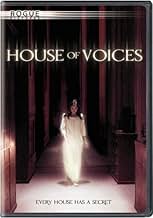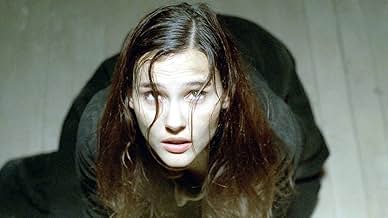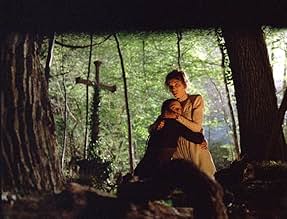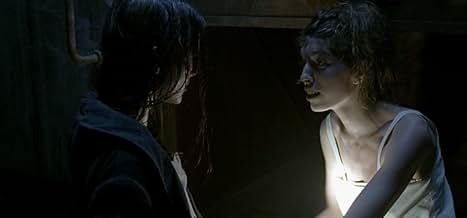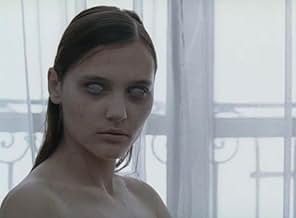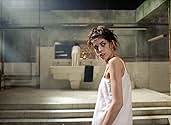IMDb रेटिंग
5.0/10
5.1 हज़ार
आपकी रेटिंग
अपनी भाषा में प्लॉट जोड़ेंAnna is a servant who accepts a post at the St. Ange. She arrives to confront an unsettling lack of orphans, save for one. Then the bizarre sights and sounds begin, which seem to elude detec... सभी पढ़ेंAnna is a servant who accepts a post at the St. Ange. She arrives to confront an unsettling lack of orphans, save for one. Then the bizarre sights and sounds begin, which seem to elude detection by the other servant or the gloomy director.Anna is a servant who accepts a post at the St. Ange. She arrives to confront an unsettling lack of orphans, save for one. Then the bizarre sights and sounds begin, which seem to elude detection by the other servant or the gloomy director.
Christophe Lemaire
- Un homme des services sociaux
- (बिना क्रेडिट के)
Louis Thevenon
- Un déménageur
- (बिना क्रेडिट के)
Franck Vestiel
- Man in Black
- (बिना क्रेडिट के)
फ़ीचर्ड समीक्षाएं
"House of Voices," the first feature film by Pascal Laugier, contains many of the elements that made his 2008 cult-classic "Martyrs" so great. Both films start off in a predictable, genre-specific way -- then gradually reveal darker, stranger, subterranean layers that defy our expectations. Of the two films, "House" is lighter fare, while "Martyrs" is far bloodier and much, much more disturbing.
"House of Voices," begins as a slow-build Gothic ghost-story, in the vein of 2007's "The Orphanage" or 2001's "The Others." "House" works quite well on this level, featuring engaging female performances, a slowly-unravelling mystery, some handsome cinematography, a lush dramatic score, and some moments of genuine dread. But then, in its final act, the film takes a sharp and surprising turn toward the surreal. I could describe what happens in these scenes, but what really makes them work is the way they're filmed -- the simple strange visual power of these moments. Suffice to say, while you might have a general idea where the plot of this movie is headed, you will probably not foresee exactly how it arrives there.
The final scenes of this movie plumb some nightmarish depths, departing stylistically from the subtle Gothic-horror which came before, and entering far stranger territory. Don't worry; it all adds up. This isn't one of those horror films which leads you on, only to end with such strangeness that you have no hope of understanding what the movie was about. No, everything here makes sense in terms of the film's plot. It's just that the film's sudden stylistic change is jarring and surreal, evoking the kinds of unexpected shifts we might experience in our deepest nightmares.
For me, this movie worked quite well. I see some others here have given it bad reviews. I gather that's because they don't know how to tell a thoughtful, well-made film from worthless pap like the "Saw" franchise. This certainly isn't the best movie I've ever seen, but it's a very fine, thoughtful, moderately scary film with a bizarre final act that might haunt you afterward.
If you like this film, and you have a strong stomach, I'd certainly recommend Laugier's "Martyrs." It plays the same stylistic tricks as this film, but much more intensely, and to greater effect. Word of warning, though: It is a far more disturbing film than "House of Voices."
"House of Voices," begins as a slow-build Gothic ghost-story, in the vein of 2007's "The Orphanage" or 2001's "The Others." "House" works quite well on this level, featuring engaging female performances, a slowly-unravelling mystery, some handsome cinematography, a lush dramatic score, and some moments of genuine dread. But then, in its final act, the film takes a sharp and surprising turn toward the surreal. I could describe what happens in these scenes, but what really makes them work is the way they're filmed -- the simple strange visual power of these moments. Suffice to say, while you might have a general idea where the plot of this movie is headed, you will probably not foresee exactly how it arrives there.
The final scenes of this movie plumb some nightmarish depths, departing stylistically from the subtle Gothic-horror which came before, and entering far stranger territory. Don't worry; it all adds up. This isn't one of those horror films which leads you on, only to end with such strangeness that you have no hope of understanding what the movie was about. No, everything here makes sense in terms of the film's plot. It's just that the film's sudden stylistic change is jarring and surreal, evoking the kinds of unexpected shifts we might experience in our deepest nightmares.
For me, this movie worked quite well. I see some others here have given it bad reviews. I gather that's because they don't know how to tell a thoughtful, well-made film from worthless pap like the "Saw" franchise. This certainly isn't the best movie I've ever seen, but it's a very fine, thoughtful, moderately scary film with a bizarre final act that might haunt you afterward.
If you like this film, and you have a strong stomach, I'd certainly recommend Laugier's "Martyrs." It plays the same stylistic tricks as this film, but much more intensely, and to greater effect. Word of warning, though: It is a far more disturbing film than "House of Voices."
Saint Ange starts pretty amazing and sets you in the movie's gloomy mood immediately but the truth is that the movie is bad. The settings for the movie are indeed very good and with a solid storyline and correct flow the movie would have been a great one. The shots, colors, lighting and close ups are truly amazing but it's a shame that the movie starts to bore you after halfway, also there are lots of things that don't really make sense leaving you confused and in the end it's somewhat unbearable so you pray for it to end finally. My 3 rating is only because the film's photography is truly brilliant otherwise i would have sticked to 1.
OK, so the film isn't great, but it surely ain't awful either. It is reminiscent of other films, The Innocents and The Others to name but two, but there's no harm in that. There's very few films today that could be called truly original these days. Originality doesn't matter, it's the telling of the story that matters, and like the aforementioned, this film moves at a slow pace, admittedly too slow at times but it does deliver a certain creepiness and suspense. Where this film falls down for some (taking into consideration the comments already left) is that it doesn't end with an explanation. But so what? Like The Innocents you are left to come up with your own conclusions and I for one like it when the facts aren't spelled out to me in cinematic semaphore. Ambiguity is all but lost under the onslaught of mind-numbing American releases that offer nothing but 90 minutes of entertainment and then nothing. Saint Ange is a film you can chew on for days afterwards. It's very well shot, capably acted and offers a few shivers along the way. Not nearly as bad as people would have you believe.
From the tone of these comments you would think this was the worst film ever made (and a few comments say that literally). It wasn't as good as "The Others" and such, but the worst movie ever? Please. It was well shot and the minimalist production design was a welcome break from hyper-stylized films like "Silent Hill". The story did take a long time to develop, but the tension built nicely and it had an Argento feel to me. Not every movie has to be "Transformers", moving at Mach 10 from the first frame. Maybe the more subtle storytelling nature was why everyone reacted so poorly. It certainly didn't beat you over the head with plot points, and did feel like a key scene or two was left out of the final cut (setting up the kittens for example) but overall was a nice, spooky little film. Everyone's opinion is valid if course, and it's nowhere near my favorite film, but I had to defend it for some reason. Maybe it's because there are so many TRULY bad films out there, and I want people to save their venom for the movies that deserve it.
For the life of me, I cannot understand the fierce and almost resentful nature of many of the opinions given here. I was fully prepared to see another one of those over-blown affairs that put style over substance and usually bore me to bits after 15 minutes or so of their Amélie"-type smugness and undeserved self-confidence. In fact. SAINT ANGE is a very careful, very sensitive story of a young woman who struggles with her feelings about her impending motherhood. The ending made perfect sense to me, whether read as a ghost story of sorts or a paranoid fantasy. The actresses are uniformly excellent, particularly Virginie Ledoyen and Lou Doillon, as is Catriona MacColl, who you might still remember from those colorful Fulci extravaganzas from the early eighties. The splendid photography makes good use of the grey and cold blue colours of the orphanage, which is embedded in green and brown tones – Mother Nature. The fantasy ending also introduces a clinical white for good measure. In view of the many cinematic exercises of today that talk their subtexts to death, SAINT ANGE uses a formal elegance that is breath-taking. Actually, I didn't find one single frame that was superfluous. In a way, the film also shares several themes with Laugier's well-received and harrowing MARTYRS, as it is basically another – albeit more tender – tale of a bruised young woman under dire circumstances. The ending of MARTYRS can also be read as a paranoid fantasy, with traces of hope hidden in a complex framework of depressing human depravity. No, I liked SAINT ANGE a lot. And, by the way, Joe Lo Duca – who started with Sam Raimi's THE EVIL DEAD – delivered a haunting and memorable music score. An excellent movie.
क्या आपको पता है
- ट्रिवियाShot back to back in two versions, one in French and the other in English.
- गूफ़(at around 15 mins) The movie is supposed to take place in 1958, as the opening scenes state. When the children leave the house in the beginning of the movie, one of the cars accompanying the buses full of children is clearly a white Peugeot 404. Peugeot introduced this model in 1960, and made it available to the public a year later.
- कनेक्शनReferenced in Viande d'origine française (2009)
- साउंडट्रैकI'm in the Mood for Love
Performed by Vera Lynn, Charlie Kunz and the Casani Club Orchestra
Music by Jimmy McHugh
Lyrics by Dorothy Fields
© Famous Music corp. C/o BMG Music Publishing France with BMG Music Vision approval
(P)1983 Decca Records Company ltd with the kind participation of Universal Music Projets Speciaux
टॉप पसंद
रेटिंग देने के लिए साइन-इन करें और वैयक्तिकृत सुझावों के लिए वॉचलिस्ट करें
विवरण
बॉक्स ऑफ़िस
- बजट
- €53,20,000(अनुमानित)
- दुनिया भर में सकल
- $67,82,283
- चलने की अवधि1 घंटा 38 मिनट
- रंग
- ध्वनि मिश्रण
- पक्ष अनुपात
- 2.35 : 1
इस पेज में योगदान दें
किसी बदलाव का सुझाव दें या अनुपलब्ध कॉन्टेंट जोड़ें



